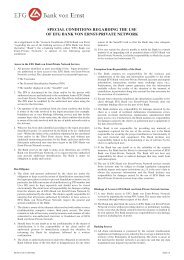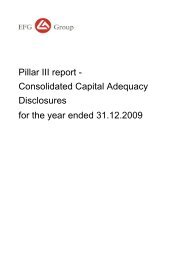as at December 31, 2003 - EFG Bank Group
as at December 31, 2003 - EFG Bank Group
as at December 31, 2003 - EFG Bank Group
You also want an ePaper? Increase the reach of your titles
YUMPU automatically turns print PDFs into web optimized ePapers that Google loves.
Notes to the Financial St<strong>at</strong>ements<br />
1. Description of business activity<br />
<strong>EFG</strong> <strong>Bank</strong> European Financial <strong>Group</strong> is engaged<br />
in priv<strong>at</strong>e banking and acts <strong>as</strong> the Parent <strong>Bank</strong> for<br />
the <strong>EFG</strong> <strong>Bank</strong> <strong>Group</strong>.<br />
In its capacity <strong>as</strong> a priv<strong>at</strong>e bank, a full range of<br />
services is offered, supported by the oper<strong>at</strong>ional<br />
and IT infr<strong>as</strong>tructures of its Swiss priv<strong>at</strong>e<br />
banking subsidiary, <strong>EFG</strong> Priv<strong>at</strong>e <strong>Bank</strong> SA.<br />
The Company’s role <strong>as</strong> a holding company is<br />
performed in a number of ways. The <strong>Group</strong><br />
Board of Directors and Committees are<br />
supported by departments within the Parent<br />
<strong>Bank</strong>: the <strong>Group</strong> Risk Unit, <strong>Group</strong> Finance<br />
Department, <strong>Group</strong> Control and Regul<strong>at</strong>ory Unit<br />
and <strong>Group</strong> Internal Audit (through the <strong>Group</strong><br />
company, <strong>EFG</strong> Audit and Consulting Services).<br />
Through these entities, the <strong>Bank</strong> supervises its<br />
subsidiaries and ensures th<strong>at</strong> all risk<br />
management, control environment, financial<br />
reporting and other relevant Swiss regul<strong>at</strong>ory<br />
responsibilities are met on a <strong>Group</strong>-wide b<strong>as</strong>is.<br />
At <strong>December</strong> <strong>31</strong>, <strong>2003</strong>, the number of staff<br />
employed by the <strong>Bank</strong> w<strong>as</strong> 16 (2002:16).<br />
2. Accounting policies, risk<br />
management and outsourcing<br />
(a) Accounting policies<br />
The st<strong>at</strong>utory financial st<strong>at</strong>ements have been<br />
prepared in accordance with the accounting and<br />
valu<strong>at</strong>ion principles laid down in the Swiss Code<br />
of Oblig<strong>at</strong>ions, the Federal Law on <strong>Bank</strong>s and<br />
Savings <strong>Bank</strong>s, the Swiss <strong>Bank</strong>ing Ordinance and<br />
the Directives of the Swiss Federal <strong>Bank</strong>ing<br />
Commission on Accounting Standards. These<br />
principles require th<strong>at</strong> the st<strong>at</strong>utory financial<br />
st<strong>at</strong>ements show a prudent view of the financial<br />
position and result of oper<strong>at</strong>ions.<br />
Each <strong>as</strong>set and liability are valued on an<br />
individual b<strong>as</strong>is.<br />
Transaction recording and present<strong>at</strong>ion in the<br />
balance sheet<br />
All transactions of the <strong>Bank</strong> are entered into its<br />
books on the day they are transacted. The<br />
Annual Report <strong>2003</strong><br />
balance sheet is prepared according to the<br />
following principles: securities transactions, <strong>as</strong><br />
well <strong>as</strong> payments, are entered in the balance sheet<br />
on the day of transaction; deposits and loans, <strong>as</strong><br />
well <strong>as</strong> spot and forward/foreign exchange<br />
transactions, are entered in the balance sheet on<br />
their respective value d<strong>at</strong>es.<br />
C<strong>as</strong>h and money market instruments<br />
Such <strong>as</strong>sets are recorded in the balance sheet <strong>at</strong><br />
their nominal value.<br />
Balances due from banks and clients, and<br />
mortgages<br />
These are st<strong>at</strong>ed <strong>at</strong> nominal value. General and<br />
specific provisions in respect of doubtful<br />
receivables are included in the balance sheet<br />
under “Valu<strong>at</strong>ion adjustments and provisions”.<br />
Financial investments<br />
Securities are held on a medium or long-term<br />
b<strong>as</strong>is, i.e. until their m<strong>at</strong>urity. Bonds held for the<br />
medium term are valued <strong>at</strong> the lower of cost or<br />
market value. Bonds held for the long-term, i.e.<br />
until their m<strong>at</strong>urity, are valued under the straightline<br />
method. Equities are valued <strong>at</strong> the lower of<br />
cost or market/fair value.<br />
Reductions in market value below cost are<br />
recorded in the st<strong>at</strong>ement of income under<br />
“Other ordinary expenses”. Any subsequent<br />
incre<strong>as</strong>es in market value of previously writtendown<br />
financial investments up to initial cost are<br />
recorded in the st<strong>at</strong>ement of income under<br />
“Other ordinary income”.<br />
Investments in subsidiaries<br />
Such <strong>as</strong>sets are st<strong>at</strong>ed <strong>at</strong> the acquisition price less<br />
any write-downs to reflect a prolonged<br />
diminution in value.<br />
Fixed <strong>as</strong>sets<br />
Fixed <strong>as</strong>sets comprise buildings owned by the<br />
<strong>Bank</strong>, fixtures and fittings, computer and<br />
telecommunic<strong>at</strong>ion equipment, and other office<br />
equipment, the purch<strong>as</strong>e cost of which, or the<br />
project they rel<strong>at</strong>e to, exceeds CHF 10’000.<br />
Purch<strong>as</strong>es below this threshold are expensed.<br />
69





